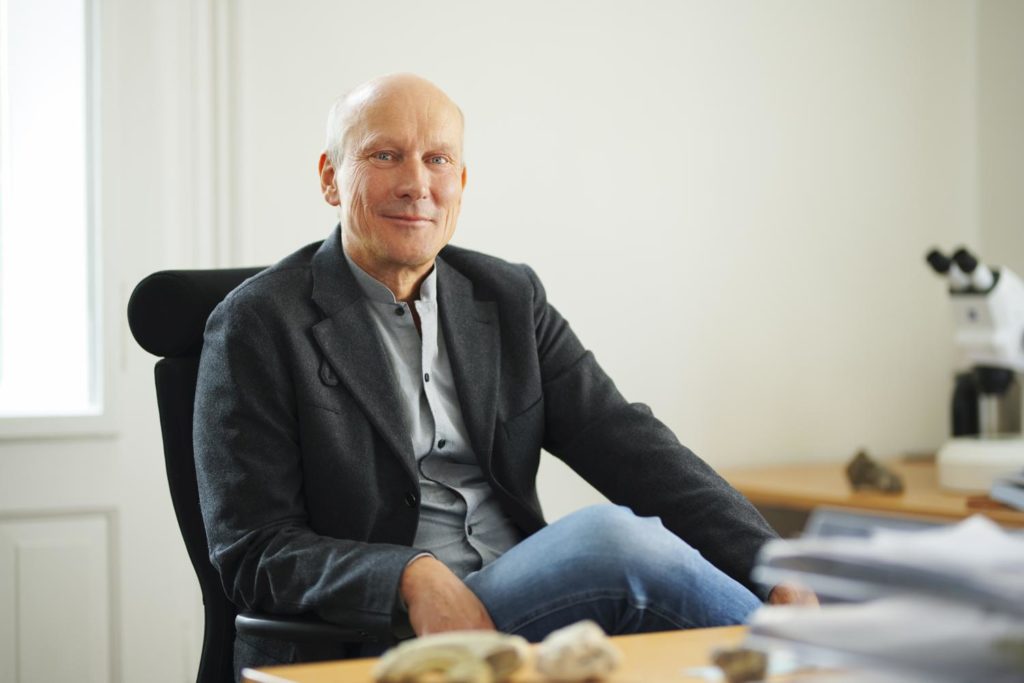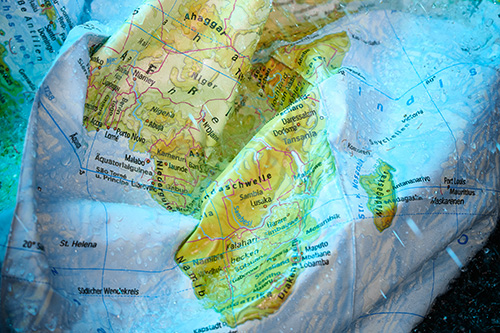Professor Kießling, how does someone become a lead author on the Intergovernmental Panel on Climate Change?
First you are nominated for this voluntary work, then you have to apply. Hans-Otto Pörtner from the Alfred Wegener Institute in Bremerhaven asked me in 2016 if I wanted to get involved. He has already played a leading role on the IPCC for a very long time and had noticed that my subject area, palaeobiology and palaeoenvironment, was hardly represented on the IPCC.
What contribution can palaeontology, the study of the evolution of animals and plants, make to the climate change taking place today?
As we know, there were already times in the past when the climate changed substantially as a result of natural influences. For example, a good 200 million years ago, gigantic amounts of lava poured out of the Earth in a relatively short space of time at the spot where the Atlantic Ocean is today and ultimately covered eleven million km2, about 2.6 times the area of the present European Union. Together with this lava, vast quantities of the greenhouse gas carbon dioxide were released into the air. It’s possible that other natural processes further intensified the greenhouse effect, and temperatures worldwide rose at that time by around 4 to 6 °C. At the same time, around 70 percent of all species disappeared from Earth during that period. Together with my team, I’ve been studying the connections between these two events for many years. This knowledge can give us important clues about how current climate change is already influencing nature and above all about how it will influence it in future. This knowledge is precisely what needs taking into consideration by the IPCC too.

Is that the reason why you applied for the IPCC?
Correct. Like all the other applicants, I submitted my CV and described my scientific expertise with the help of a few important publications. I applied for Working Group II of the IPCC, which assesses the impacts, adaptation and vulnerabilities related to climate change. Working Group I, on the other hand, examines the physical and meteorological background behind climate change, while Working Group III investigates measures that can be used to slow down and ultimately stop climate change. The IPCC’s Executive Committee then selects suitable candidates. It ensures that all regions worldwide and diverse groups are adequately represented in order to incorporate different perspectives. These can, after all, differ considerably, for example between European, North and South American, African, Oceanic and Asian countries. This is precisely what an intergovernmental body of the United Nations must take into consideration.
How do these IPCC groups operate?
In total, about a thousand people are involved in the IPCC, around 300 of which are in Working Group II. This group’s report is divided into 18 chapters. Since most of my research is on the world’s oceans, I am working on the chapter about oceans. I am also coordinating one of seven interdisciplinary chapters that is investigating the effects of climate change on hotspots of biodiversity. Apart from that, I’m also writing a general article together with a colleague from the USA on the influence of natural climate change on earlier natural and cultural communities. It’s a summary of paleontological and archaeological findings.
Then and now
In the TERSANE research group funded by the German Research Foundation, Wolfgang Kießling and his team are looking at extreme climate events in the history of our planet: How did periods of extreme heat come about? How great were the associated environmental changes? And what concrete impact did these have on marine animals and ecosystems? The aim is to map out the conditions under which climate change can trigger mass extinction.
Does your work with the IPCC differ from your research at FAU?
There is a very fundamental difference: in the natural sciences, we present new findings and results in our publications. In the IPCC, we don’t conduct research, but collect all the existing knowledge relevant to each area. We then categorise it according to certain criteria and in the process review, for example, whether a paper is a meta-analysis in which new findings are derived from several studies that have already been published. We assess the knowledge collected in this way according to strictly scientific criteria and summarise it in an objective report.
How extensive is such a report?
The report by Working Group II will appear in February 2022 and therefore had to be submitted by the beginning of September 2021. It’s around 2000 pages in length, which has involved a huge amount of work that we have to do in addition to research and teaching.
At first glance it might seem that each of the 300 participants in Working Group II was on average expected to write less than seven pages.
Although that sounds manageable, in practice it’s quite a different matter. We discuss every single point in detail among ourselves until we arrive at a common, objective wording. This text is then reviewed externally three times. In the first round, everyone with proven scientific expertise can comment. Later on in the process, governments can also make their own comments. Some 1,800 comments were submitted on ‘Oceans’ alone, which is, after all, just one of 25 chapters in Working Group II. Each comment is dealt with and discussed in detail, not a single one is ignored. After all, we’re acting on behalf of the United Nations and the entire world.[PK1]
And where does the world stand right now? Can we still achieve the 1.5 °C target?
For this to happen, the entire planet would have to reduce the overall net balance of greenhouse gas emissions to zero by 2050. This is what it says in the report produced by IPCC Working Group I, which was submitted in August 2021. Of course, this also applies for those countries and areas where climate gas emissions are currently still rising. If even rich Europe has no hope of reaching this goal before 2050, that shows how time is already running out. Personally, I don’t believe that we can achieve this worldwide.

What measures does the IPCC recommend in this situation?
The IPCC itself does not issue any specific recommendations, and that is not its remit either. We only assess the scientific literature and derive statements from it that can be translated into guidelines. These statements, in turn, are clear: climate change has long arrived, and we must adapt to its effects. The consequences can be seen everywhere. For example, extreme weather events, such as storms, floods, droughts and fires, have doubled since the 1990s. A reduction of emissions will help us to adapt, but mitigation alone will not save the world.
What are the impacts on the oceans?
Sea levels will rise by up to 70 centimetres by the end of this century. Because the climate system reacts very sluggishly, this rise can no longer be prevented through climate protection measures but at most attenuated a little. This means that if we do nothing, we’ll lose a lot of land along our coastlines.
Does that mean we ought to reinforce and raise barriers straight away?
Such technical measures are very expensive and soon reach their limits. Natural systems are much better as well as cheaper. In warmer regions of the world, these nature-based solutions include, for example, coral reefs and mangrove forests. Both not only protect the coasts from erosion and storm damage but are also very important for the marine ecosystem. Not only a community of worms, sponges, echinoderms, molluscs and crustaceans lives in the coral reefs, for example. Many fish living in the open water also have their nursery there, in which their offspring are relatively well protected. In addition, we can accomplish two goals at the same time: mangrove forests not only protect the coast but are also a fantastic carbon store that slows down climate change.
What impact is climate change already having today on marine life?
Water temperature plays a significant role here. If it gets too warm, many fish quickly get into difficulty. If they can, they escape to cooler regions. For example, cod are increasingly migrating from the North Sea and could presumably disappear completely from the Baltic Sea within this century. Since the 1960s, not only many fish species but also corals, for example, have moved around 50 kilometres polewards each decade. This trend is likely to accelerate in future.
Is this migration successful everywhere?
No, the animals also come up against natural boundaries again and again. In the Mediterranean, for example, they can initially migrate to the slightly cooler waters further north. However, at the latest at the French Mediterranean coast they find themselves in a dead end. And they have more or less no means of escape because the water heats up on their way back south. But migration can easily fail in regions without such natural boundaries too. Sooner or later, populations in marine protected areas reach their limits. Should they then find their way into regions that are already overfished anyway, their chances of survival sink rapidly. To prevent such developments, corridors to protected areas further north can be set up beforehand along which the animals can safely migrate.
Does this migration cause problems for other species?
Over the past decades, many species have moved north from the Red Sea through the Suez Canal to the cooler waters of the Mediterranean. This is called Lessepsian migration after Ferdinand de Lesseps, the entrepreneur behind the Suez Canal’s construction. These species from the Red Sea then reappear on Israel’s coasts and those of neighbouring regions. This area is therefore considered to be the marine ecosystem that is most affected worldwide by an invasion of alien species.
Do species have other possibilities to escape climate change?
They could also move to deeper water. This is, however, anything but easy: far less light penetrates the water at greater depths. As a result, fewer algae grow there, which use light to produce organic substances from carbon dioxide and in the process produce oxygen at the same time. This means that migrant species find less oxygen in deeper waters, which they need, however, to live, just like animals on land.
What other problems does climate change cause for our oceans?
In the mass extinction events of the past, a deadly trio often played a deciding role. If carbon dioxide concentration in the air rises, this greenhouse gas not only heats up the air and later the water as well, but also increasingly enters the water. As a result, the water becomes more acidic and causes problems over time for organisms that protect themselves from enemies with a hard calcareous shell. If the water becomes more acidic, they have much more difficulty secreting calcium carbonate and sooner or later stop secreting it at all. Acidification is therefore an enormous problem, apart from water temperature.
About Professor Wolfgang Kießling
Professor Wolfgang Kießling holds the Chair of Palaeontology at GeoZentrum Nordbayern and is also lead author of two chapters of the report by Working Group II of the Intergovernmental Panel on Climate Change (IPCC), which is concerned with climate change impacts, adaptation and vulnerability.
What is the third factor in this deadly trio?
In warmer water, much less oxygen dissolves. At the same time and with rising temperatures, the organisms of fish and other water dwellers run in top gear and therefore need more oxygen. But this can lead to an overall meltdown: 250 million years ago, climate change and the oxygen depletion it triggered forced numerous species into a corner, until in the end many of them became extinct. Above all, the combination of oxygen depletion and rising temperatures is therefore extremely dangerous. We should therefore pay particularly close attention to this in the context of climate change.
Are there also boundaries on land similar to those in the sea for species seeking to escape climate change?
We find such boundaries on land even more often than in the sea. For forest species, for example, a vast agricultural landscape, in which there are perhaps no hedges either, quickly forms an insurmountable barrier. Settlements or wide and busy traffic routes can also form such a boundary, which many species are scarcely able to cross, like deserts or high mountains. Here too, forest corridors or hedgerows between fields and meadows would provide important connections, along which wildcats, for example, could slink to the next trees. We should therefore adapt to climate change as well as we can on land too.
About the author
Roland Knauer has a doctoral degree in natural sciences, and lives and works as a journalist and author with a focus on natural sciences in Lehnin.
FAU research magazine friedrich

You can order the print issue (only available in German) free of charge at presse@fau.de.
All articles

